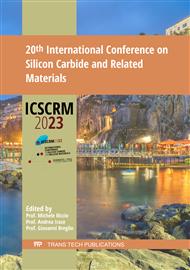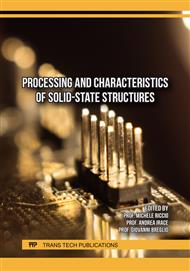[1]
J. W. Palmour, L. Cheng, V. Pala, E. V. Brunt, D. J. Lichtenwalner, G-Y Wang, J. Richmond, M. O'Loughlin, S. Ryu, S. T. Allen, A. A. Burk and C. Scozzie, IEEE Int. Symp. on Power Semi. Dev. & IC's (ISPSD), 79-82 (2014).
DOI: 10.1109/ispsd.2014.6855980
Google Scholar
[2]
D. J. Lichtenwalner, S.-H. Ryu, B. Hull, S. Allen, and J. W. Palmour, Materials Science Forum, 1090, 93-100 (2023).
DOI: 10.4028/p-3w3s88
Google Scholar
[3]
T. Kimoto and H. Watanabe, Appl. Phys. Express 13, 120101 (2020).
Google Scholar
[4]
G. Liu, B.R. Tuttle, and S. Dhar, Appl. Phys. Rev. 2, 021307 (2015).
Google Scholar
[5]
D.J. Lichtenwalner, S. Sabri, E. van Brunt, B. Hull, S.-H. Ryu, P. Steinmann, A. Romero, S. Ganguly, D.A. Gajewski, S. Allen, and J.W. Palmour, IEEE International Integrated Reliability Workshop (IIRW), 1-6 (2020).
DOI: 10.1109/iirw49815.2020.9312873
Google Scholar
[6]
J. Berens and T. Aichinger, IEEE Int. Reliab. Phys. Symp. (IRPS), 1-5 (2021).
Google Scholar
[7]
S. Zhu, T. Liu, L. Shi, M. Jin, H. L. R. Maddi, M. H. White, and A. K. Agarwal, IEEE Workshop on Wide Bandgap Power Dev. and Appl. (WiPDA), 1-4 (2021).
Google Scholar
[8]
T. Watanabe, Y. Fukui, S. Hino, S. Tomohisa, N. Miura, and K. Nishikawa, IEEE Trans. on Dev. and Mat. Reliab. 23(1), 99-108 (2023).
Google Scholar
[9]
L. Shi, T. Liu, S. Zhu, J. Qian, M. Jin, H. L. R. Maddi, M. H. White, and A. K. Agarwal, IEEE Workshop on Wide Bandgap Power Devices & Applications (WiPDA), 45-48, (2022).
DOI: 10.1109/wipda56483.2022.9955295
Google Scholar
[10]
S. Lombardo; J. H. Stathis; B. P. Linder; K. L. Pey; F. Palumbo; C. H. Tung, Journal of Appl. Phys. 98(12), 121301 (2005).
Google Scholar
[11]
D. J. DiMaria, Solid-State Electr., 41(7), 957-965 (1997).
Google Scholar
[12]
D. J. DiMaria; E. Cartier; D. Arnold, Journal of Appl. Phys. 73(7), 3367-3384 (1993).
Google Scholar
[13]
M. V. Fischetti, D. J. DiMaria, S. D. Brorson, T. N. Theis, and J. R. Kirtley, Phys. Rev. B 31(12), 8124 (1985).
DOI: 10.1103/physrevb.31.8124
Google Scholar
[14]
R. Singh, and A.R. Hefner, Solid-State Electr. 48, 1717-1720, (2004).
Google Scholar
[15]
D. K. Schroder, Semiconductor materials and device characterization, 2nd edition, Wiley, (1998).
Google Scholar



